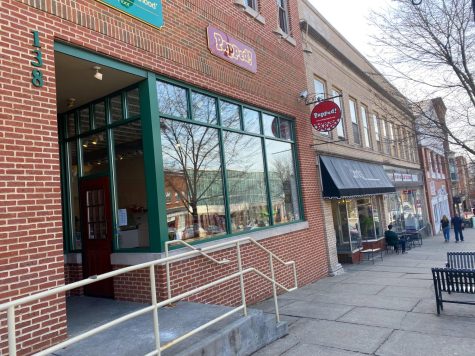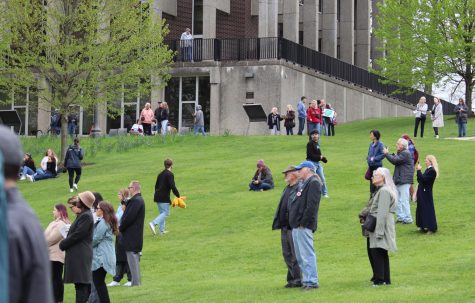Despite icy conditions, KSU not responsible
March 4, 2005
Casey Wiland, freshman nursing major, makes her way down the snowy steps by the May 4 Memorial.
Credit: Andrew popik
Students who injure themselves slipping on ice around campus have little chance of getting the university to cover their medical bills.
The sidewalks by the bus stop at the Summit East parking lot were blocked by mounds of plowed snow, and the asphalt was a sheet of ice, said Rachele Marken, a junior fashion merchandising major.
When Marken slipped on the ice Feb. 1, she broke her left fibula, which she said caused her to fall behind in her classes and lose her job.
Marken said she contacted two different law offices seeking legal action against the university, but nobody would take her case.
Lawsuits over injuries caused by ice on campus are fairly rare, said James Watson, associate university counsel. According to Ohio law, property owners do not have any liability for naturally occurring ice or snow.
“As long as we can show a reasonable attempt to maintain pedestrian areas, we will not be found at fault,” said Michael McDonald, director of Campus Environment and Operations. “Kent has always surpassed that test and gone beyond what is reasonable.”
The university usually receives one or two complaints a year about people slipping and being injured on campus, McDonald said. Handicap access receives the most complaints. He had not heard about Marken’s injury.
After missing more than two weeks of classes, Marken said she slipped and sprained her ankle inside Rockwell Hall because snow made her crutches slippery.
Even one inch of snow makes it difficult for people with disabilities to get around, Marken said.
Seven screws and a metal plate surgically repaired Marken’s leg on Feb. 4, Marken said. She will be on crutches for about four more weeks. She estimates her total medical costs will be between $5,000 and $6,000.
Joe Williams, a freshman deaf education major who uses a wheelchair, said he skipped class on Wednesday because he did not think he would be able to get around campus.
“The snow isn’t plowed in some places and is thick and slushy,” Williams said. “I often times get stuck in the snow.”
Last winter Campus Environment and Operations paid 32 employees $45,100 just to remove snow and ice, McDonald said. They spent $44,000 on salt, $5,000 on an ice melt substance and $6,620 on parts and supplies for snow and ice removal. Last January, 1,625 staff hours were spent clearing the campus.Campus Environment and Operations is trying to quickly fill three part-time positions, but has a sufficient number of full-time staff, McDonald said. He said it is hard to fill these positions because the job is so dependent on weather conditions, and it would only be temporary.
There are 22 miles of sidewalk on campus to remove ice and snow from, not including steps, ramps, loading docks or porches, McDonald said. There are 12 miles of roadway and several acres of parking lots.
“Most of the responsibility for injuries is on people walking,” McDonald said. “We certainly can’t assure people it’s going to be ice-free this time of year in Northeast Ohio.”
Marken said she has not seen the effort removing snow and ice McDonald described.
“In the spring they’re planting flowers everywhere. In the winter I never see anyone around sprinkling salt,” Marken said.
Campus Environment and Operations do not tend to flower beds while they could be taking care of snow, McDonald said.
“We put the same effort into planting flowers in the spring and summer as we put into snow removal in the winter and raking leaves in the fall,” McDonald said.
Campus Environment and Operations buys all the salt it could possibly need, McDonald said. They spend more money on salt in the winter than flowers in the spring.
Contact safety reporter Sean Joseph at [email protected].























